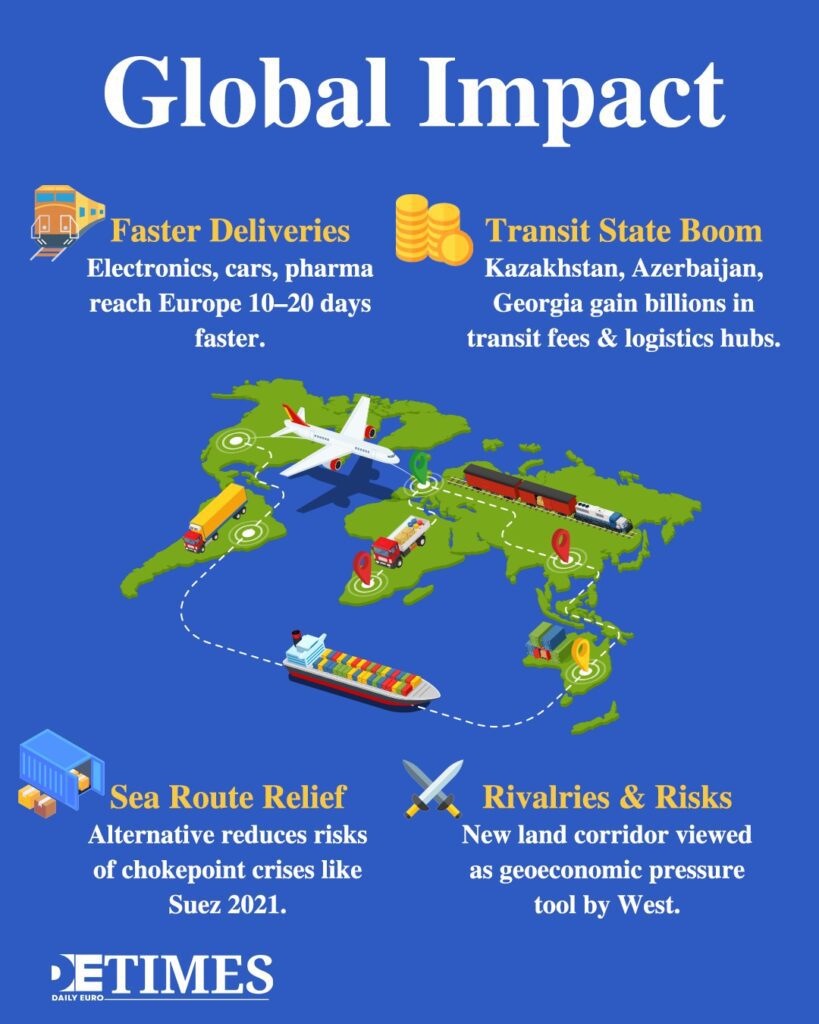China has launched a massive infrastructure project that analysts have dubbed the “Suez Canal on Rails.” The focus is Chongqing: a mountainous metropolis in the southwest of the country that is being transformed into a key logistics hub.
The new land route is intended to link Asia and Europe, bypassing sea routes and vulnerabilities such as the Suez Canal.
Ambitions
Today, Chongqing handles hundreds of freight trains daily, connecting Southeast Asia (Vietnam, Singapore) with Europe (Germany, Poland).
If delivery via the Suez Canal takes an average of 35-45 days, the railway route shortens the journey by 10-20 days.
Already in 2023, the express route "ASEAN Express" from Hanoi to Chongqing is running; it takes only 5 days and then just two weeks for goods to reach continental Europe.
It is important that Chongqing is not only a transshipment point, but also a manufacturing giant: a third of all laptops in the world and a significant part of electric cars are produced here.
The integration of production and logistics allows China to offer the market a comprehensive solution: from the factory to the European consumer.
Geopolitics at Play
The project is not just about speed, but geopolitical dependencies.
China is actively reducing its dependence on Western sea routes. The Suez Canal, the Strait of Hormuz, the Strait of Malacca are all points of control or at the the very least, supervision by Western countries, which makes supplies vulnerable in the event of a crisis.
Alternatives via Russia (the Trans-Siberian Railway) have also become less reliable against the backdrop of the war in Ukraine and European sanctions. Therefore, Beijing is betting on the so-called Middle Corridor: a route through Kazakhstan, the Caspian Sea and the Caucasus to Europe.
Risks And Challenges
Despite its prospects, the land “channel” has several loopholes:
- Customs Barriers: Each transit region, from Central Asia to the Caucasus, has its own rules that can delay the clearance of goods.
- Financial Burden: Rail transport is more expensive than sea transport. So far, the project is largely supported by subsidies under the “One Belt, One Road” initiative.
- Infrastructure Gaps: Some sections of the Middle Corridor still need large-scale modernization.
- Geopolitical Instability: Central Asia and the Caucasus are areas where any change in political course can slow down the project. Western countries can also resist the expansion of China’s influence.

Impact on Global Trade
If China manages to overcome the barriers, the land route could seriously change global trade:
- Reduced Time Lag: For exporters of electronics, cars, and pharmaceuticals; speed and predictability are important.
- Higher Gowth for Transit Countries: Kazakhstan, Azerbaijan, Georgia can receive billions through transit fees and the development of logistics hubs.
Context: One Belt, One Road
The Chongqing project is just one part of the larger One Belt, One Road initiative, which connects railways, ports and logistics from Asia to Europe and Africa. There are already projects like the Baku-Tbilisi-Kars railway and the Marmaray tunnel in Türkeye, which shortens the journey of goods to Europe to two weeks.
Other projects, such as the construction of the Eurasian Canal or the Iraqi-Turkish “Development Road,” also reflect a global trend: the world is increasingly looking for alternatives to congested and vulnerable maritime routes.
The land-based "Suez Canal" is an example of China's strategic thinking. It simultaneously solves the problem of the maritime vulnerability whilst increasing Beijing's role in global trade, supply-chain management, and in turn global politics. For transit countries, this is a chance for development and for businesses, otherwise guaranteeing stability.
However, the question of profitability remains open: the railway is more expensive, and political opening(s). in Central Asia risks disruption in the medium term. For the project to become sustainable, China needs to build trust with partners in Central Asia working alongside regimes in the region alongside Russia to susstain political and economic stability.
China’s land-based “Suez Canal” is not just a transport project, but an attempt to rewrite the rules of global trade.
If it succeeds, the map of global logistics flows will change: the key artery will not be the sea, but the railways.
Success will depend not only on technology and investment, but also on China’s ability to navigate the complex politics of Eurasia.
Read the Latest Articles on DET!
Relations in the Rear View For Now: The U.S.-India Diplomatic Crisis
A New Wave of Bioethics: The Frontiers of Genetic Engineering
Social Capital Lives On: The Story of Germany and Russia





